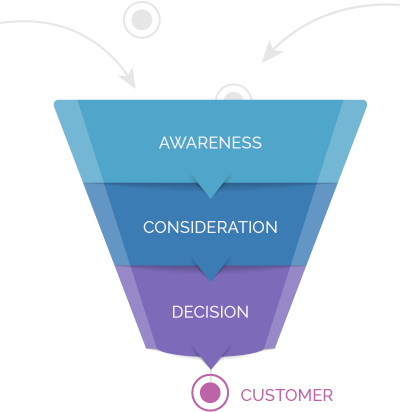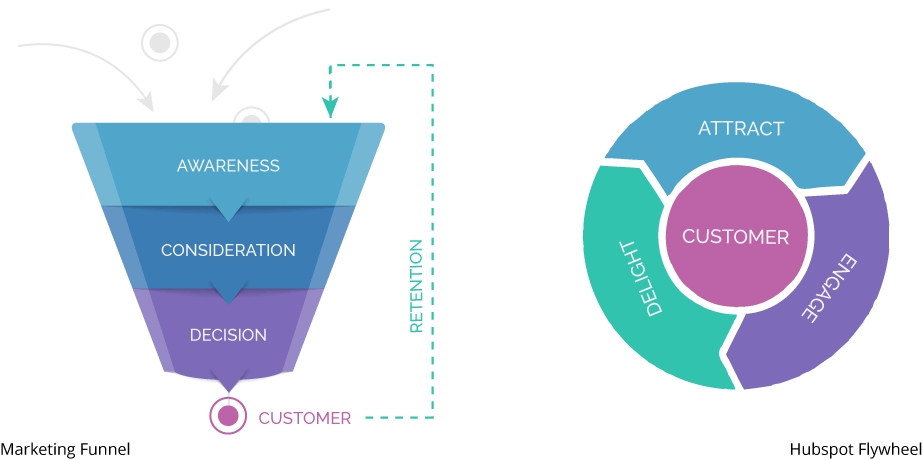What is growth marketing? It’s a question I get asked a lot. Basically, growth marketing is simply marketing 2.0 – a level up from the traditional marketing model. Growth marketing adds on layers such as A/B testing, value-add blog posts, data-driven engagement campaigns, SEO optimization, and technical analysis of every aspect of a user’s experience with your brand. What we learn from these strategies are then quickly implemented to achieve robust and sustainable growth. That entire process and feedback loop is what makes growth marketing unique.
Growth marketing goes beyond the top of the funnel.
Not familiar with the term funnel? It’s something we use frequently in growth marketing. It is also known as the pathway from a prospect to close, or another phrase I use frequently– the customer journey.
Here’s how the funnel works. At the top of the funnel, we have the prospects in the awareness stage, followed by leads in the consideration stage and then buyers in the decision stage. What comes out of the bottom of the funnel? A new customer, of course!

But you don’t measure a funnel by what goes in at the top. It’s ultimately about what comes out at the bottom; how efficient is the entire marketing process? Do you have a leak? Maybe a clog? Growth marketers know that it’s not just about more traffic– but about new users and closed sales. We focus on things like customer acquisition and conversion rate optimization to make the funnel operate more efficiently.
We also leverage post-sale strategies aimed at retention. Sometimes that means referral programs, other times it’s simply about delighting the customer. Growth marketing understands that sometimes your most efficient sale is to a former or existing customer.
In fact, marketing software leader, Hubspot, has shifted their methodology away from funnel in favor of what they call a flywheel. The flywheel incorporates the customer experience along with sales and marketing into a continuous loop. (Think pinwheel vs funnel.) Regardless of what it’s called, it’s all about making those processes as lean and efficient as possible.

Growth Marketing vs. Growth Hacking
Perhaps you’re wondering what “growth hacking” is. Is it the same thing as growth marketing? Kinda, but not really. While I used to refer to myself as a growth hacker in the early 2010s, it was mostly as a way for me to differentiate myself from other traditional marketers. You know, the old-school ones still buying up ads in newspapers and applying the “spray and pray” approach.
The term “growth hacking” originally showed up in a blog post from Sean Ellis in 2010, where he was talking about startups needing to scale quickly by focusing on customer acquisition vs product awareness. Ellis stated: “A growth hacker is a person whose true north is growth. Everything they do is scrutinized by its potential impact on scalable growth.”
There are a lot of well-known growth hacks that helped startups scale quickly. One of my favorite examples, Hotmail, is from the ’90s. At the bottom of every email sent, was this message: “PS I love you. Get your free e-mail at Hotmail” with a link. This tactic was wildly successful, yielding 12 Million users in just 18 monthsGrowth Marketing encompasses the ENTIRE marketing strategy to create efficient and sustainable growth.
But here’s where growth hacking and growth marketing differentiate for me. While they’re both aimed at rapid acquisition, growth hacking is largely tactical and one-sided. Growth marketing, on the other hand, encompasses the entire marketing strategy and experience to create efficient and sustainable growth.
I often wonder what Hotmail’s data looked like later on. Did they successfully onboard all of those users or did they sign up and never return? And later, when MSN (who bought Hotmail) tried this hack/tactic with their own MSN emails, was it as effective or had it met the point of diminishing returns?
As a growth marketer, I never want to be a one-trick-pony. So, what inside a Growth Marketing Toolbox, then?
Growth Marketing is goal-oriented.
Often when a new client comes to us, I ask them what they are trying to achieve with their marketing and they’ll answer something like — “more website visitors”. They’ve been so focused on driving traffic that they’ve neglected their actual goal of customer acquisition. I orient our marketing strategies and gameplans to keep the “eye on the prize” – new customers.
Growth Marketing is data-driven.
I obsess over data. And to clarify – I obsess over the right data (ie. not vanity metrics). What’s awesome about digital marketing is that everything is saved and counted somewhere. Leveraging data is what makes growth marketing the most efficient form of marketing. Successful growth never relies on “gut decisions”. When there is a decision to be made – whether it’s for marketing channels, search engine optimization, content marketing, conversion rates or customer acquisition costs – it’s going to be made based on the data. And if our growth marketing teams don’t already know the answer, we’re using to A/B testing to figure it out.
Growth Marketing is sustainable.
It is the understanding that there are multiple interlocking pieces to a marketing plan and when positioned correctly, they form a ladder for success. One of the secret weapons for sustainable growth for me is inbound and content marketing. An investment in quality content, with the right calls to action and search engine optimization, can reap organic traffic and leads for years to come. While traditional marketers rely heavily on paid placement, they also create a situation in which later stopping the ads will halt their growth.
Growth marketing is creative and adaptive.
It leverages out-of-the-box thinking and new ideas to give you a digital edge in marketing. We use the word experiment a lot and for good reason. With the digital landscape constantly evolving, growth marketers are always experimenting; testing and tweaking to drive up conversion rates and get ahead of the next wave. We know what worked before might not work again. That Hotmail hack I mentioned above? It worked because it was new and innovative at the time. It wouldn’t have that kind of results today.
“We can’t solve problems by using the same kind of thinking we used when we created them.” –Albert Einstein
Remember– there are no silver bullets in marketing. There is no one single trick or growth hack that will drive all of your success. But when you zoom out, growth marketing in it’s simplest form, is all about paying attention to the right data, truly understanding your users/customers, and creating user experiences that move them towards action. It is part science and part art. It’s time-consuming and hyper-focused. It’s goal oriented and data-driven. And for myself and my marketing team, there is no better way to drive business growth.


Comments are closed.